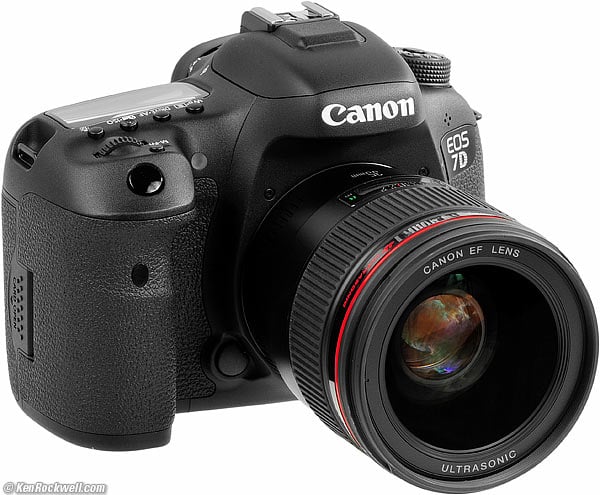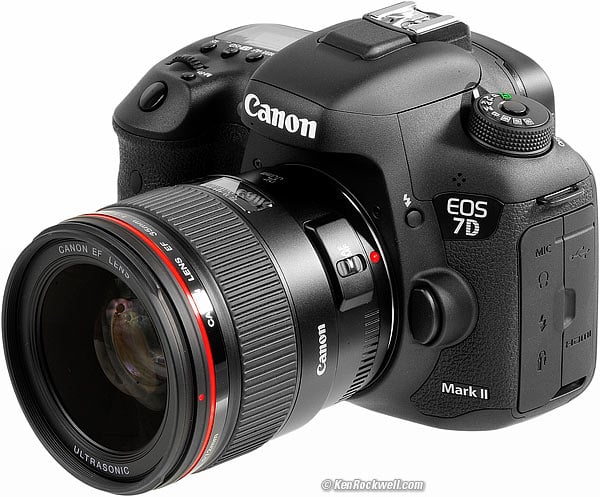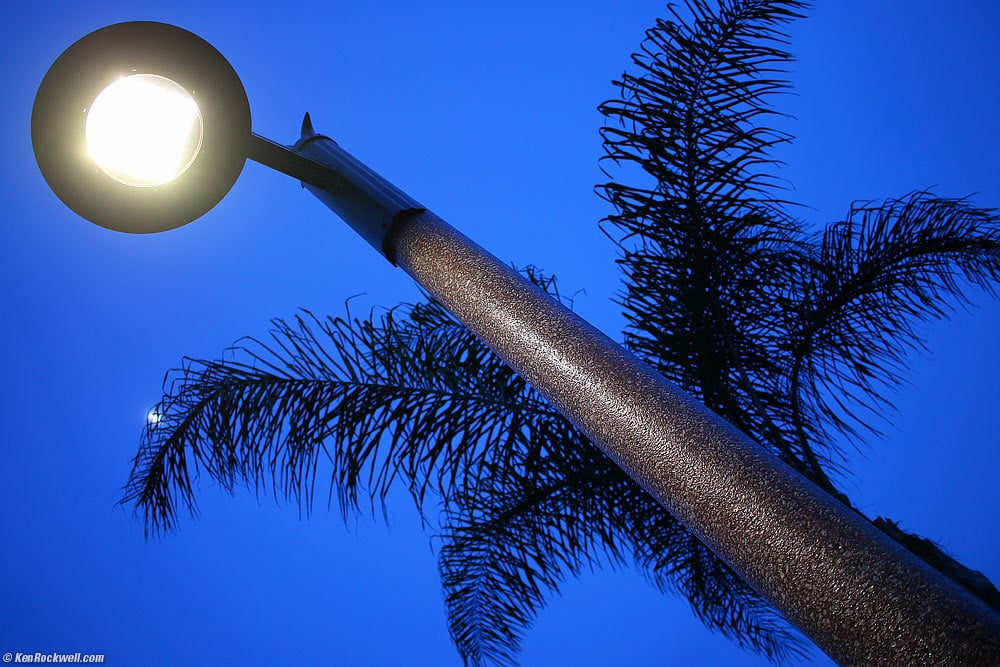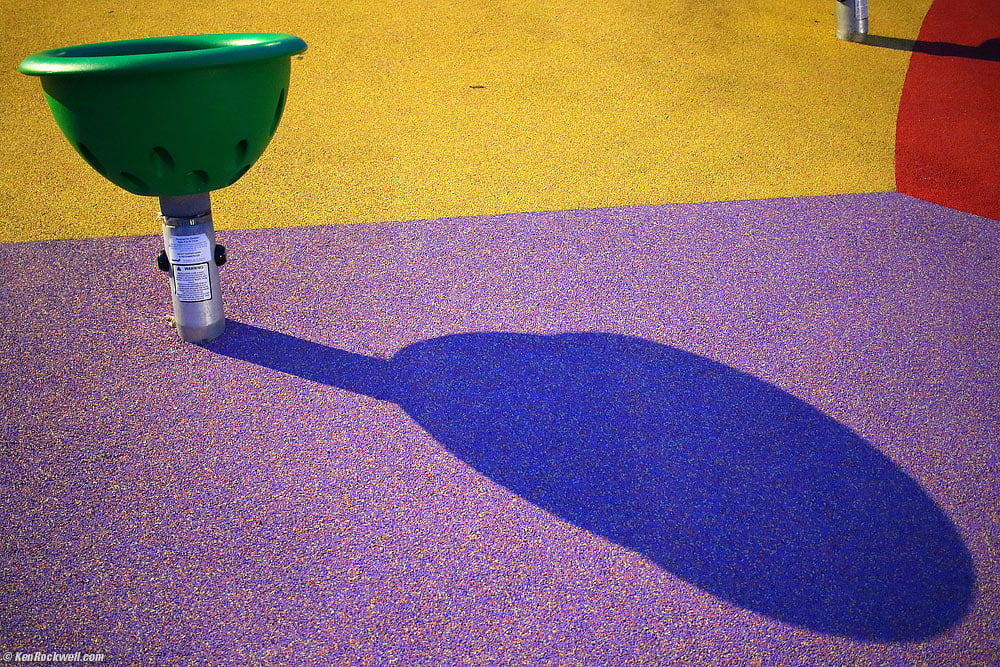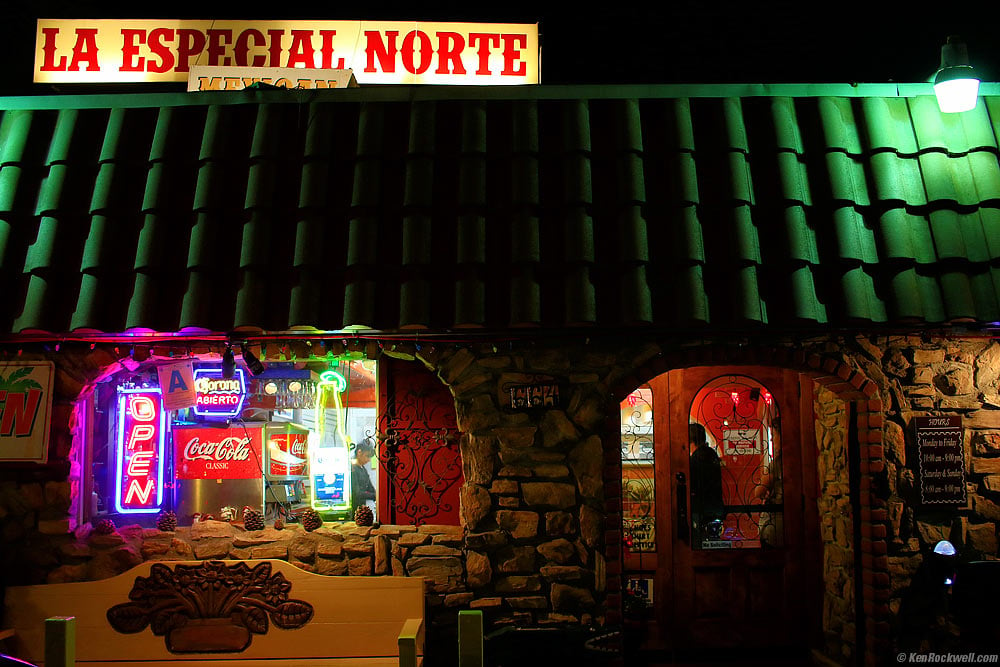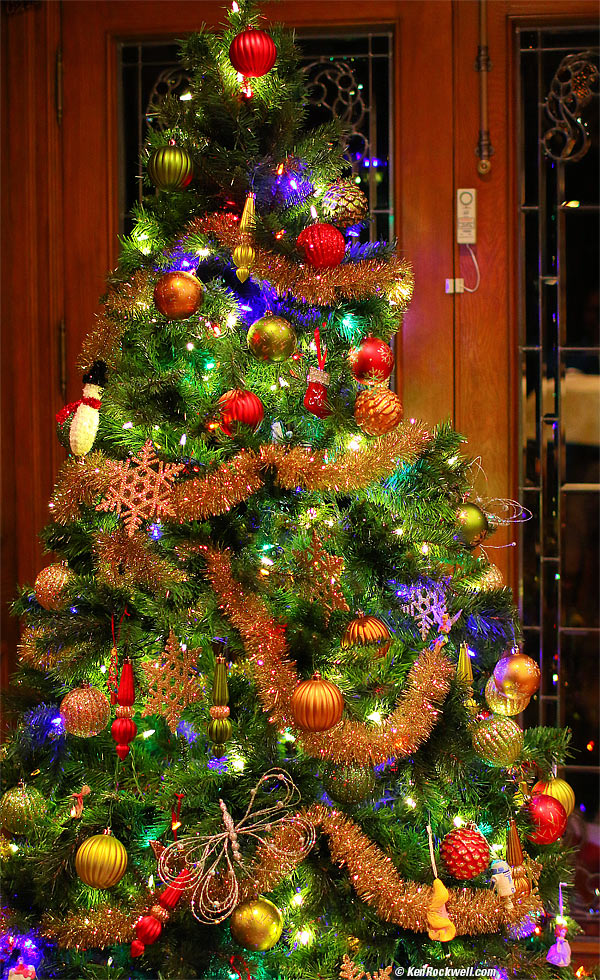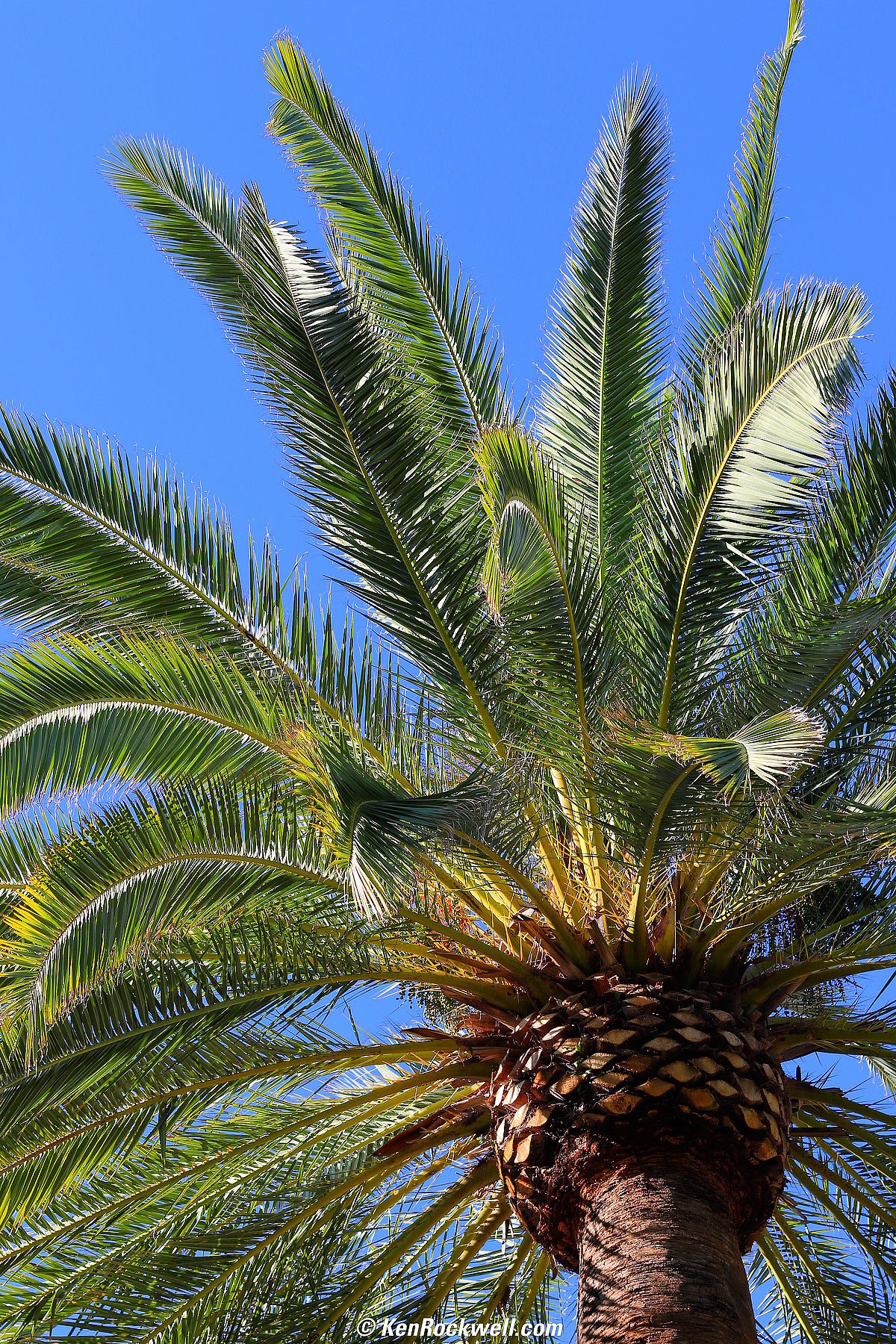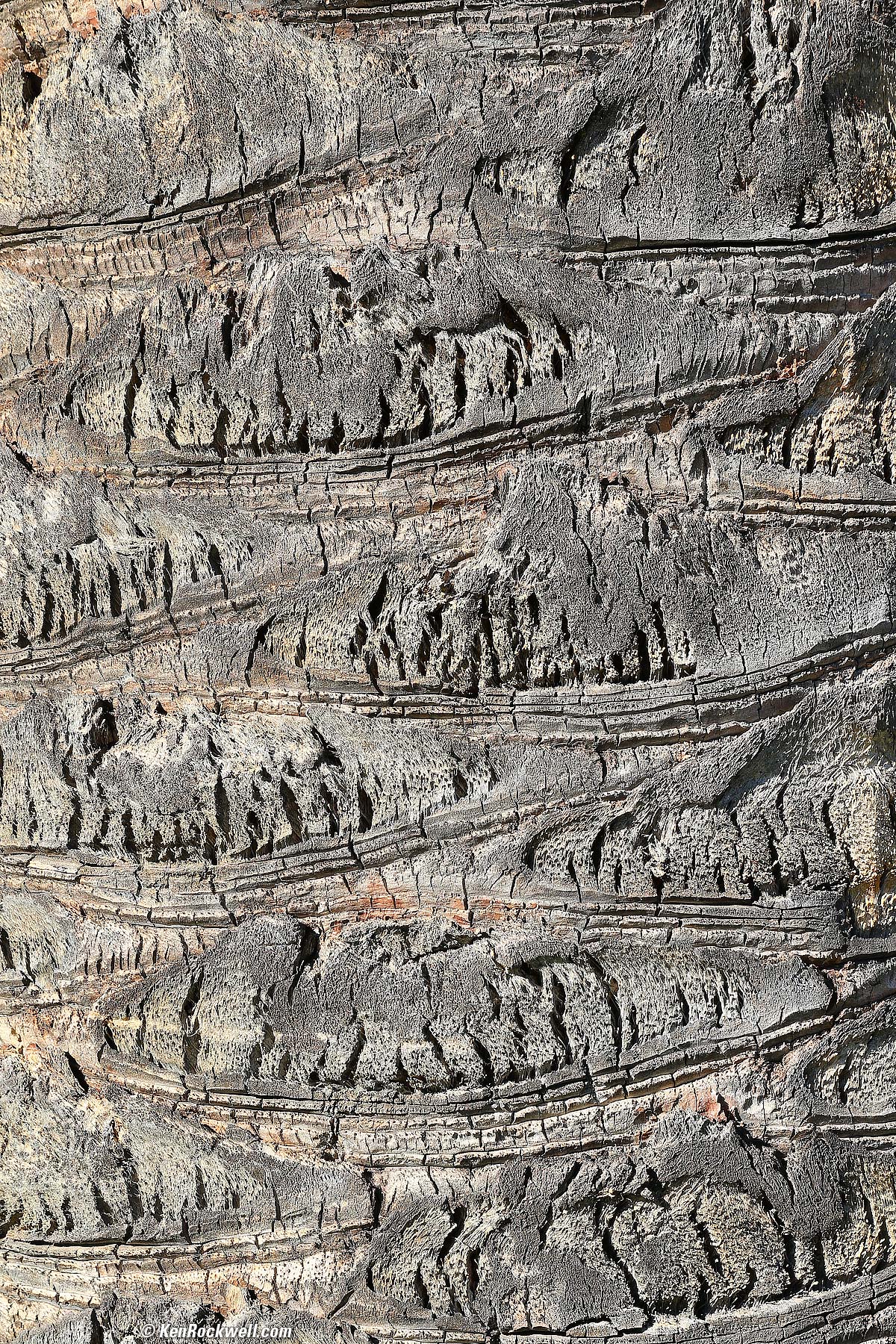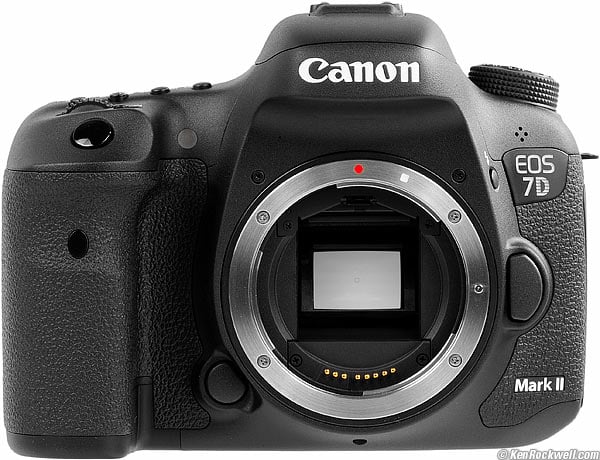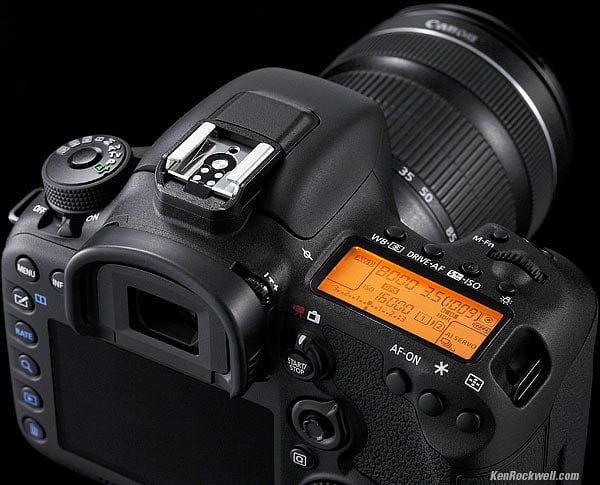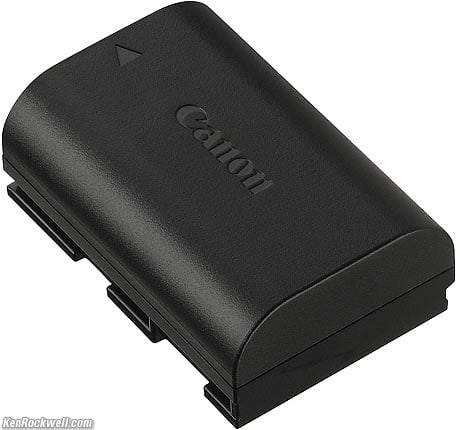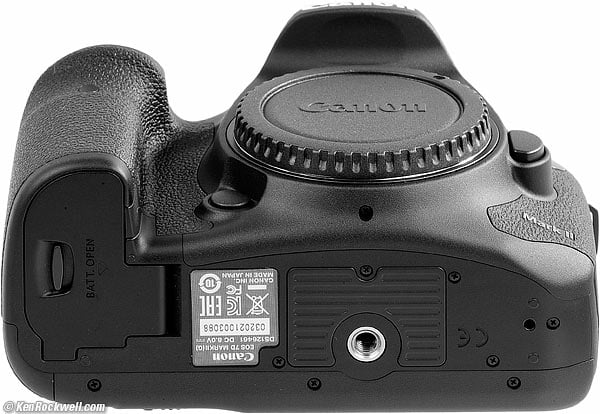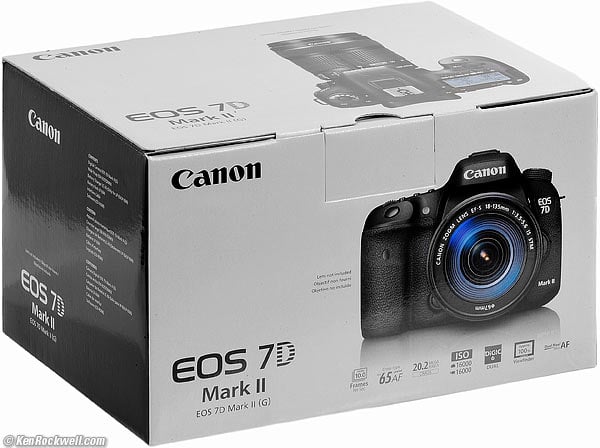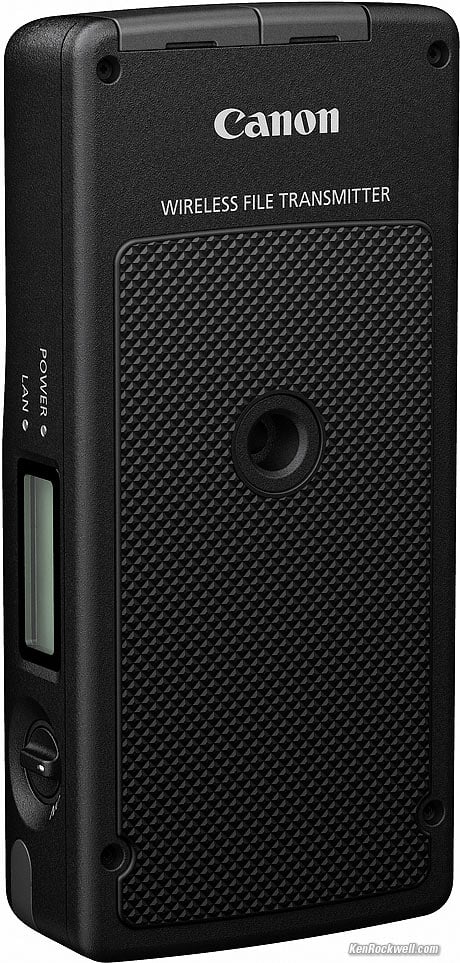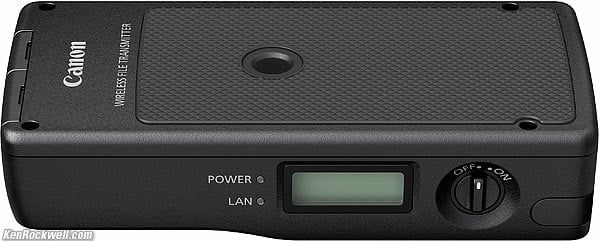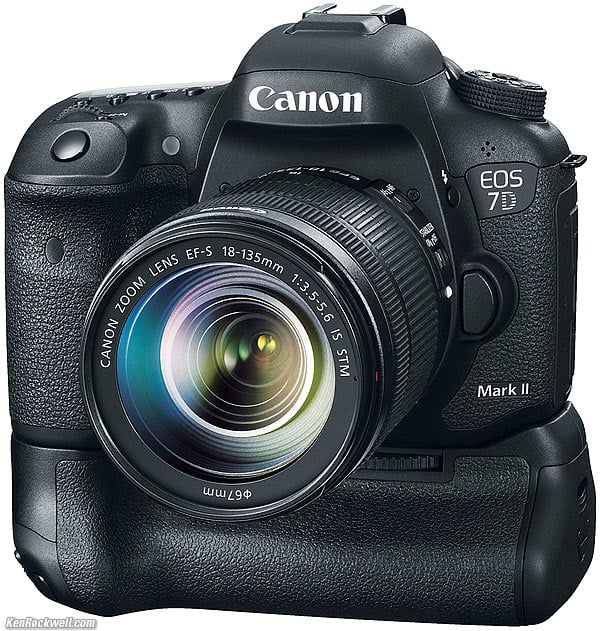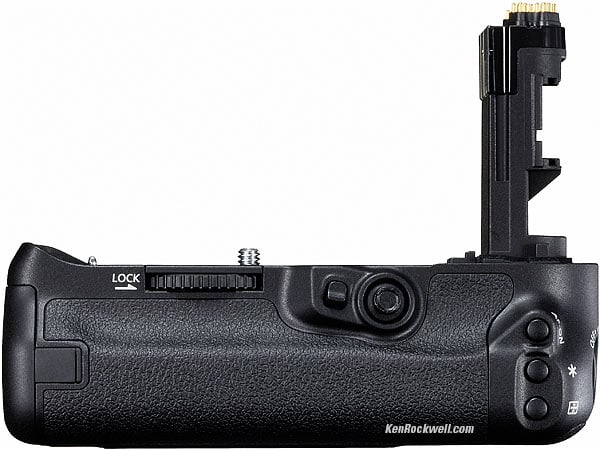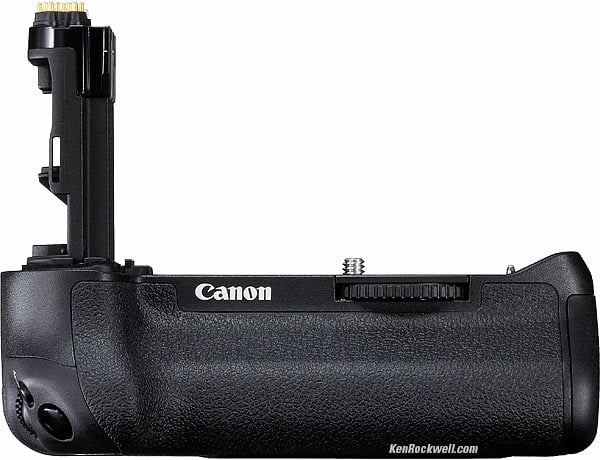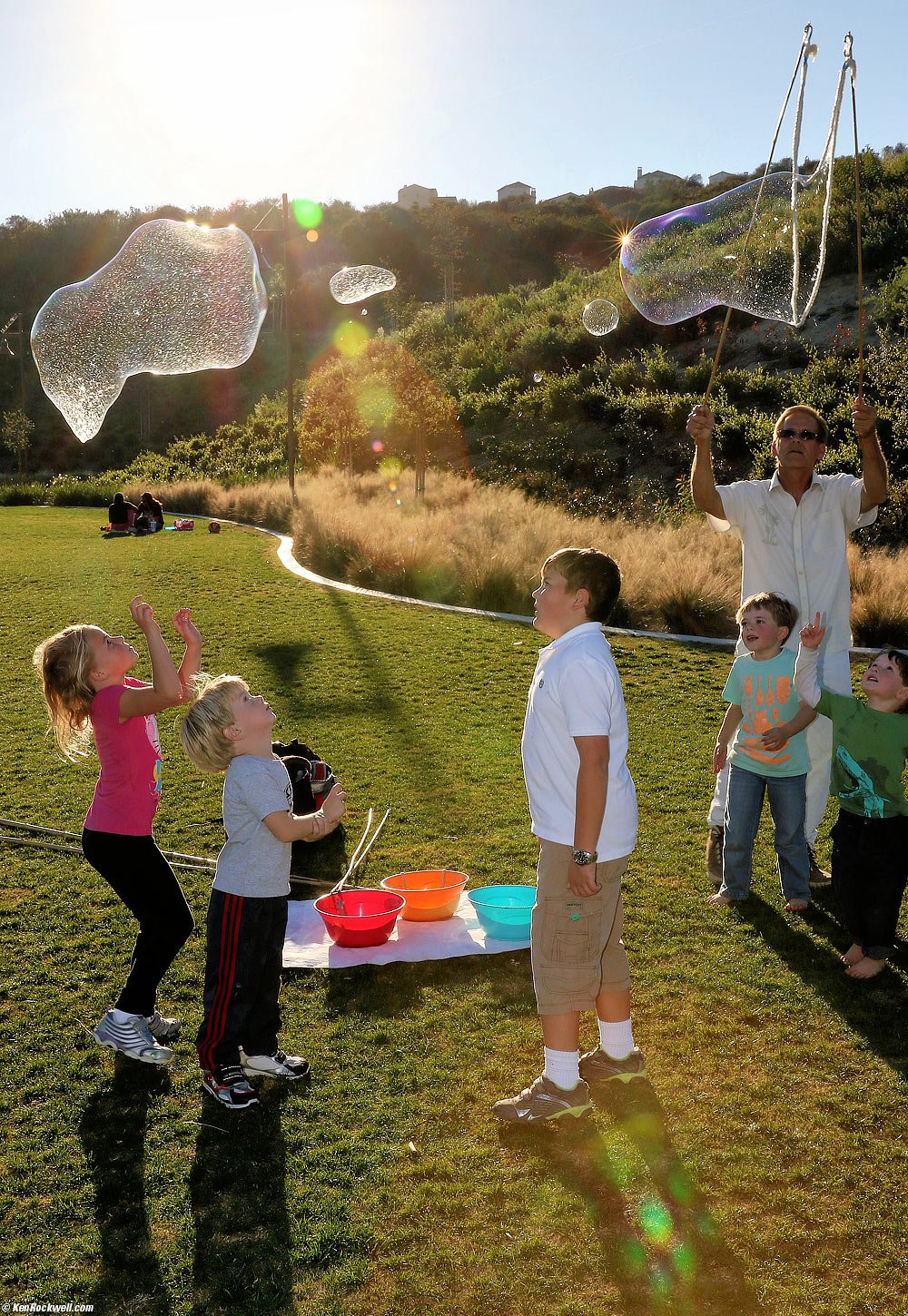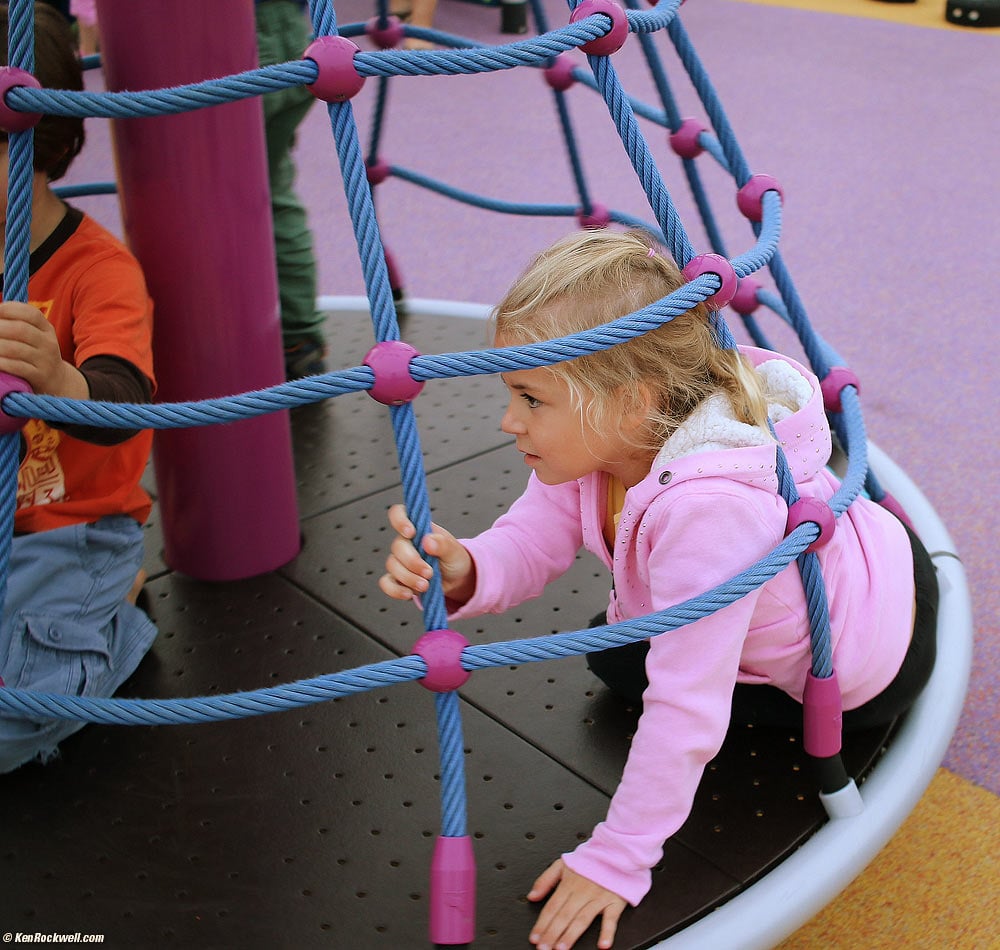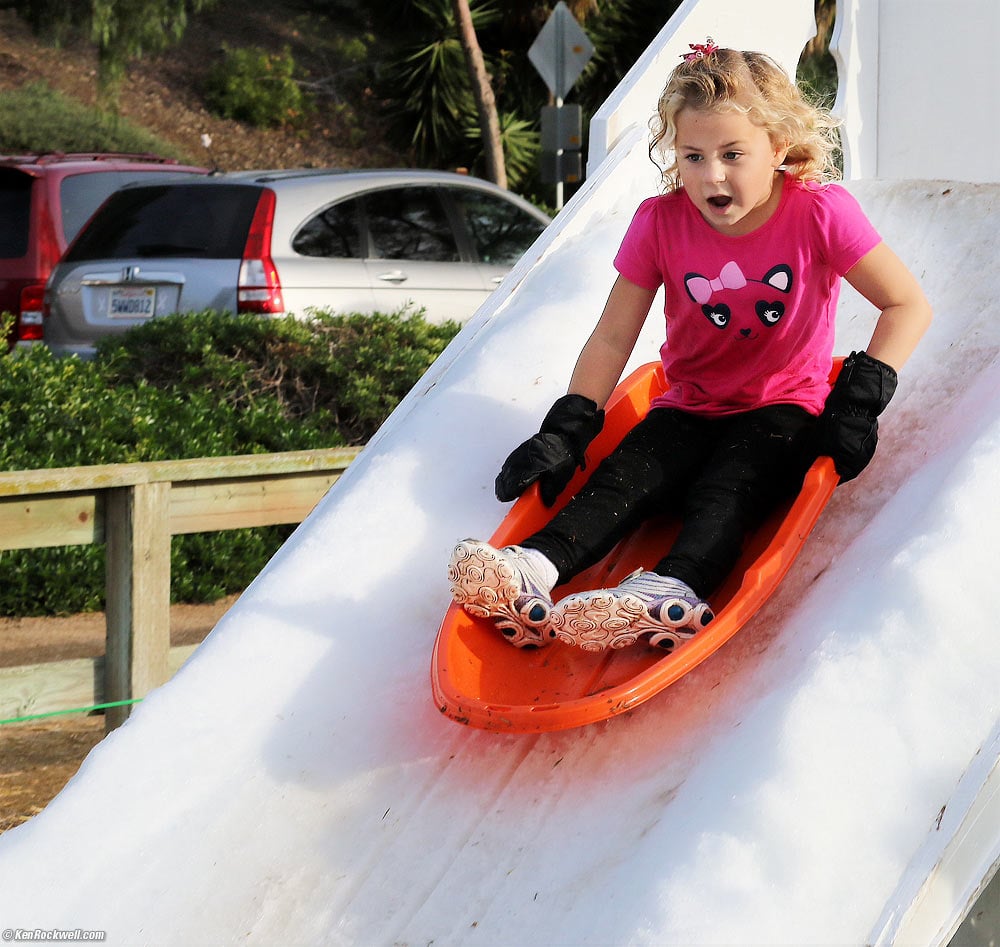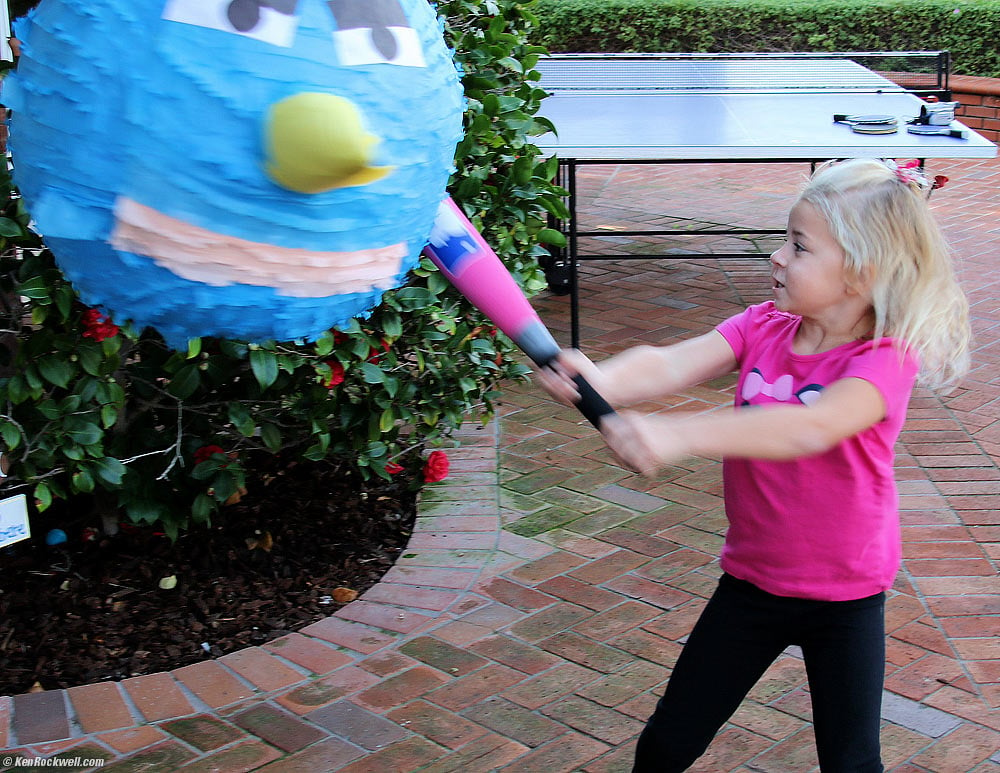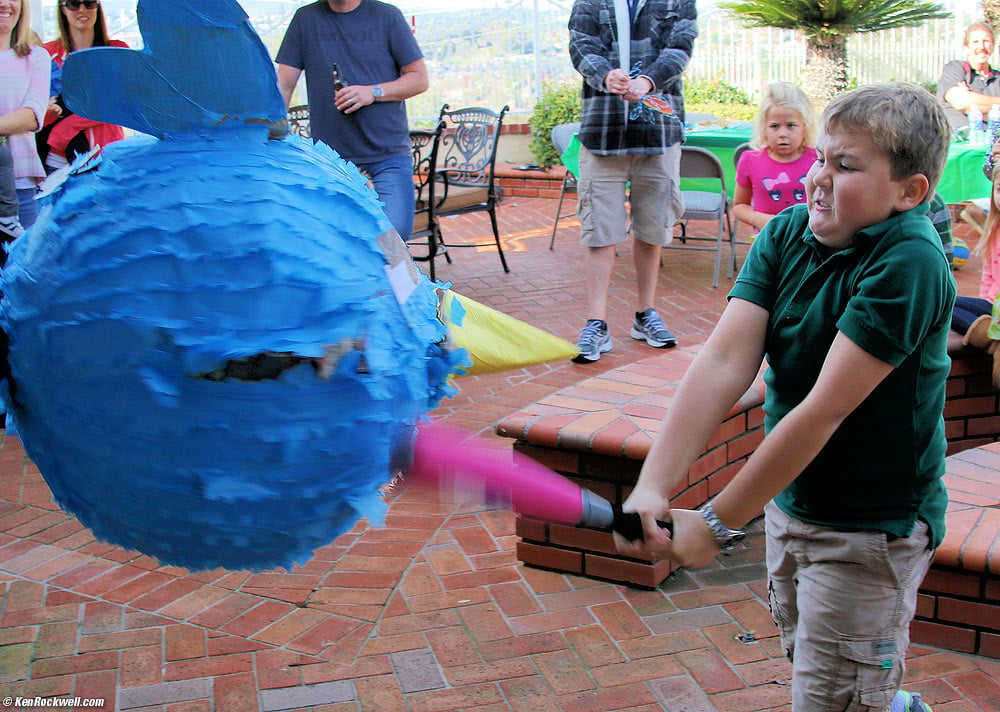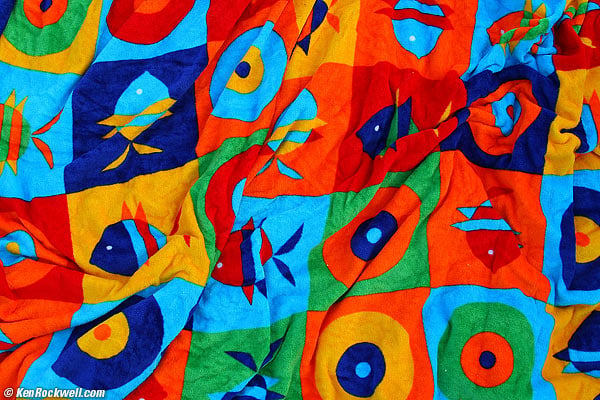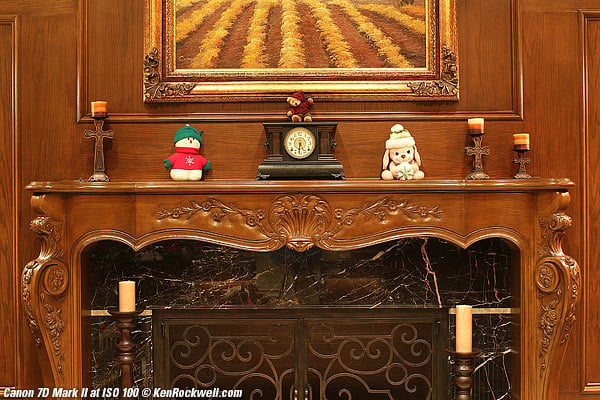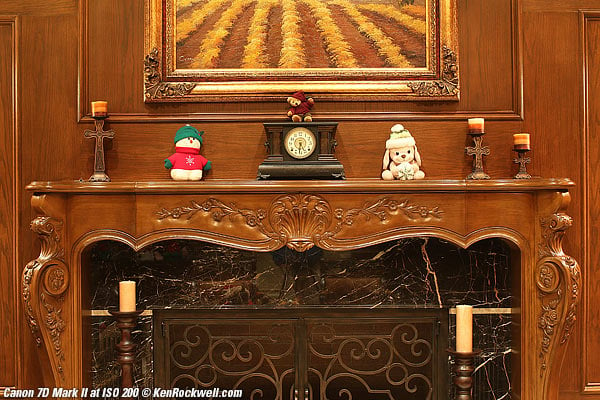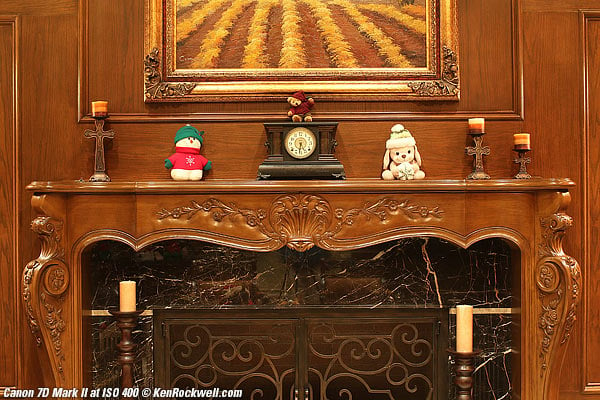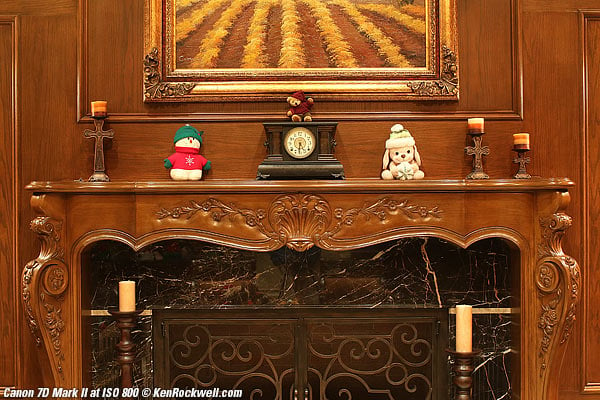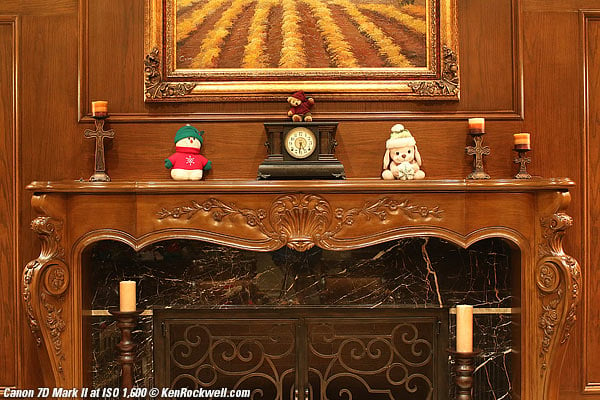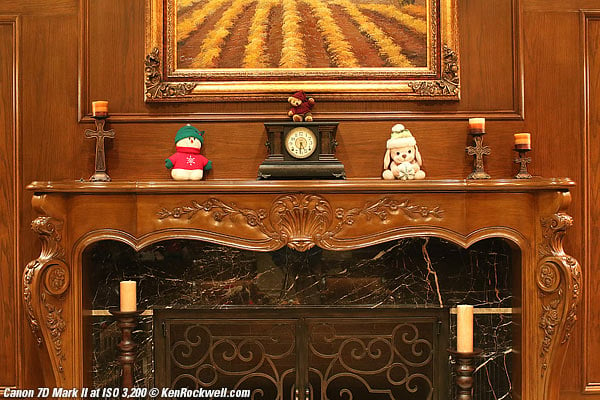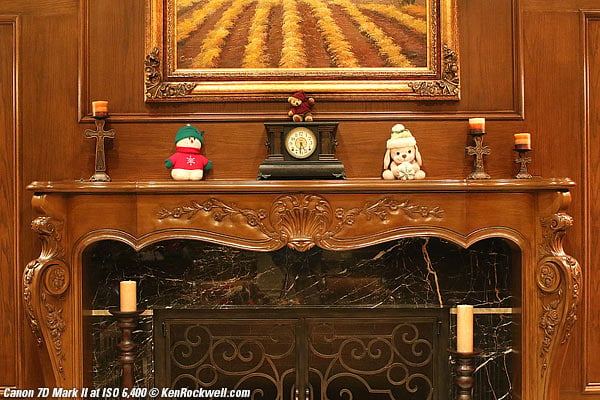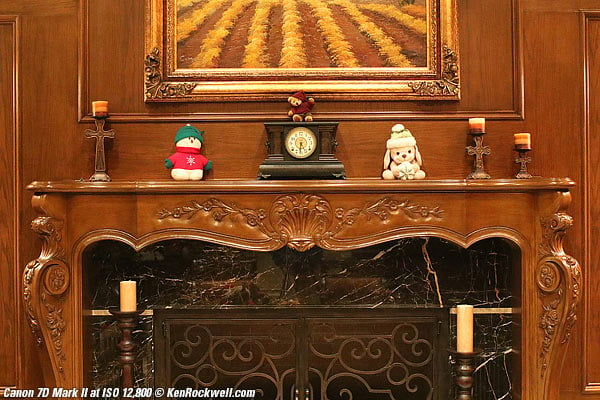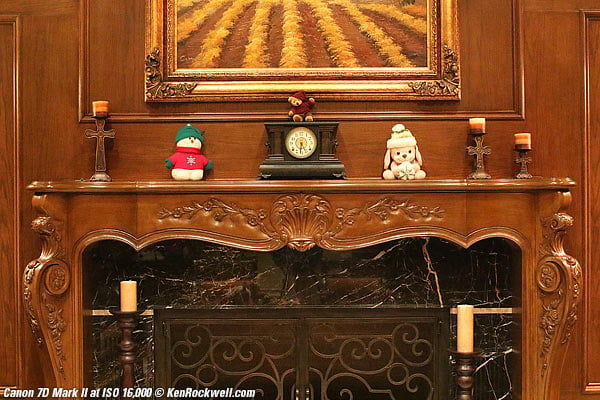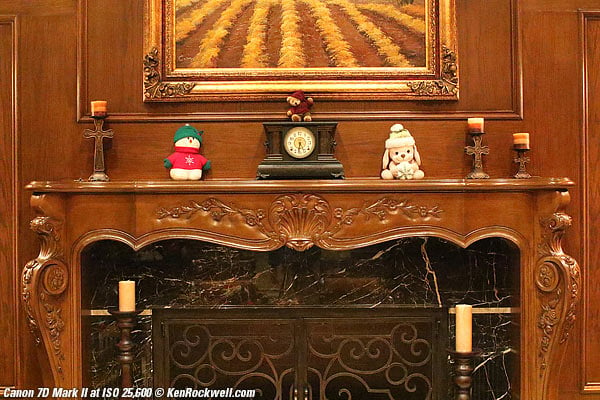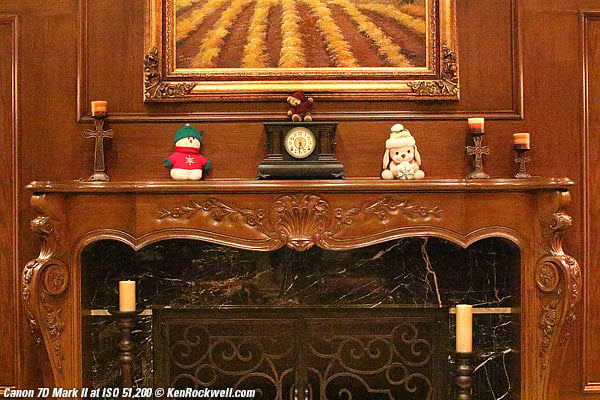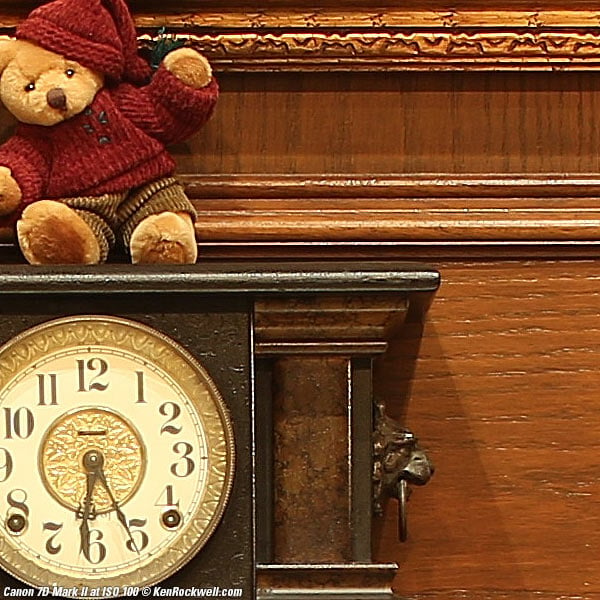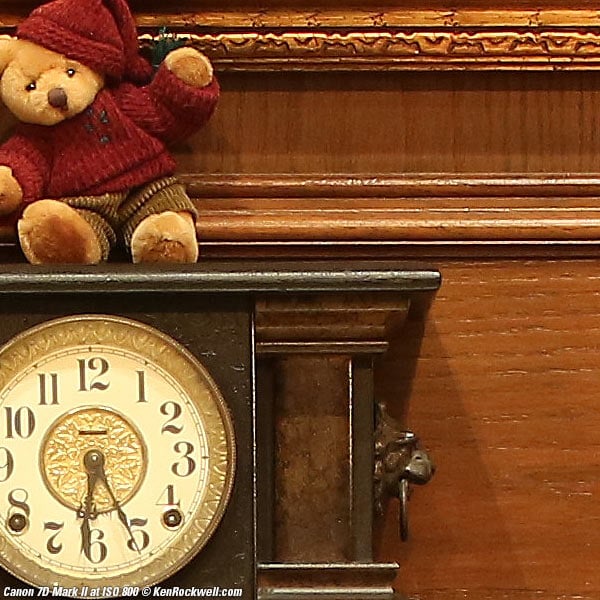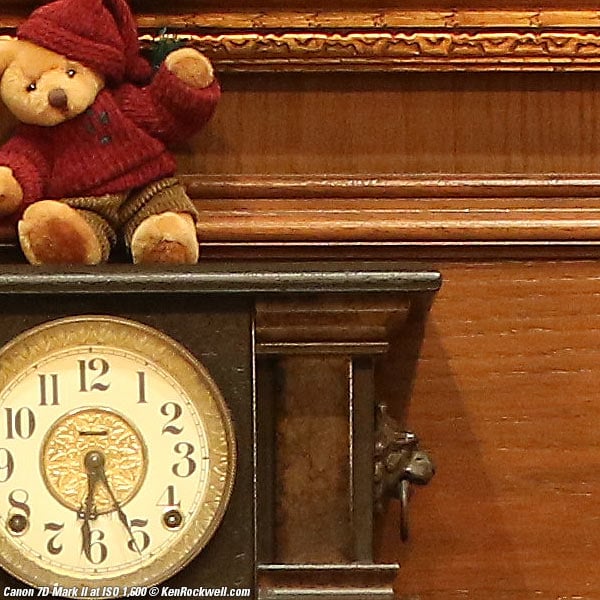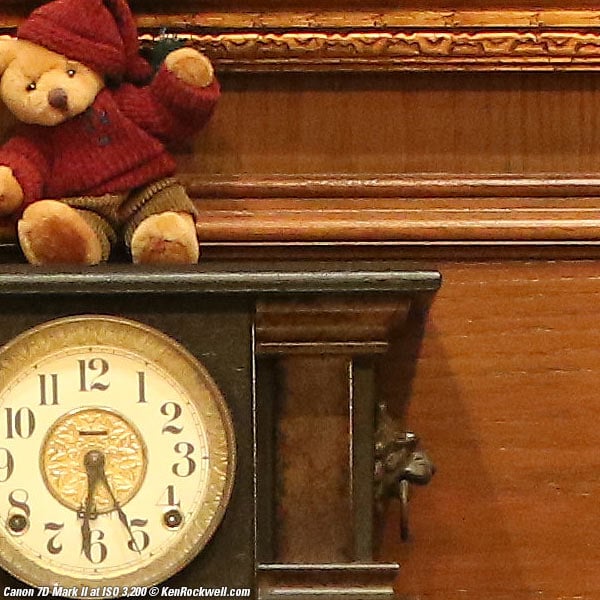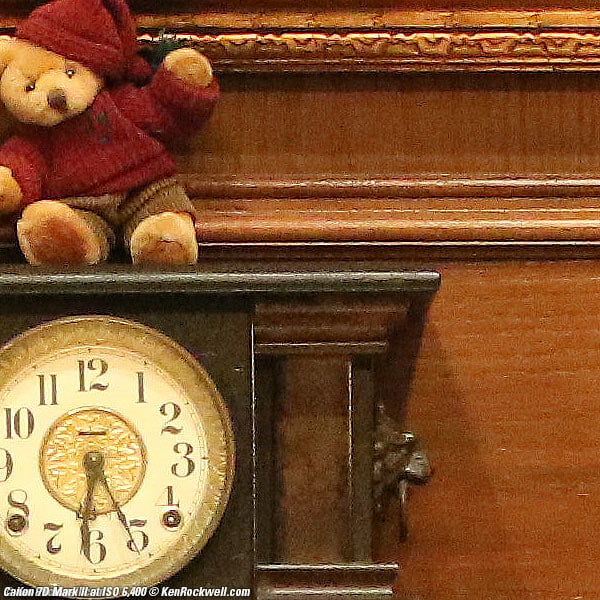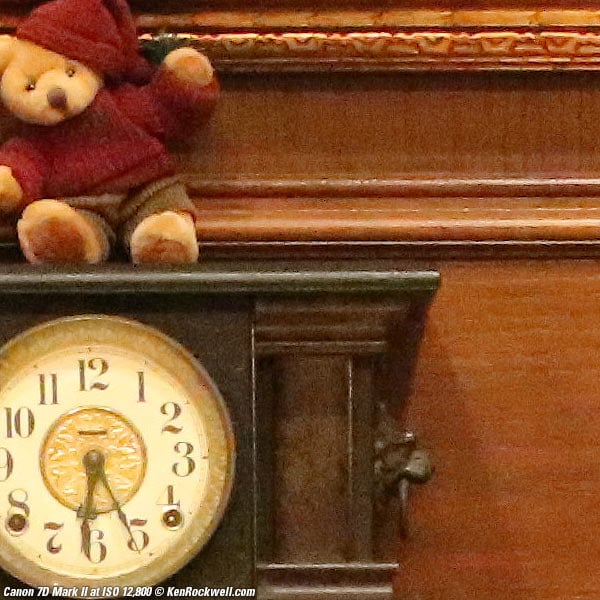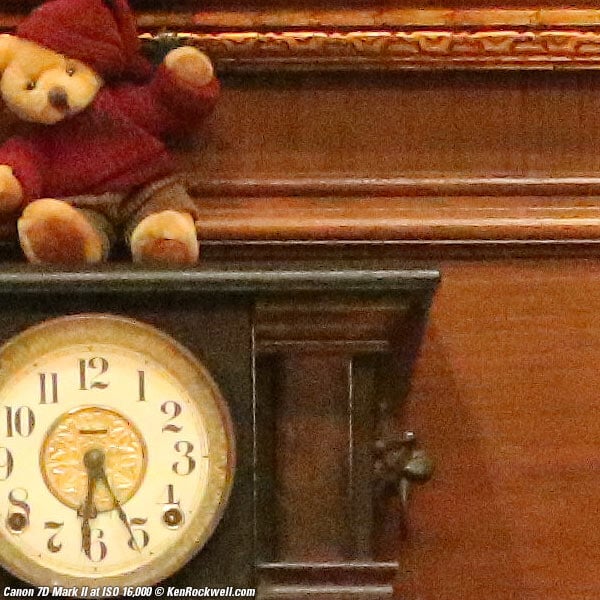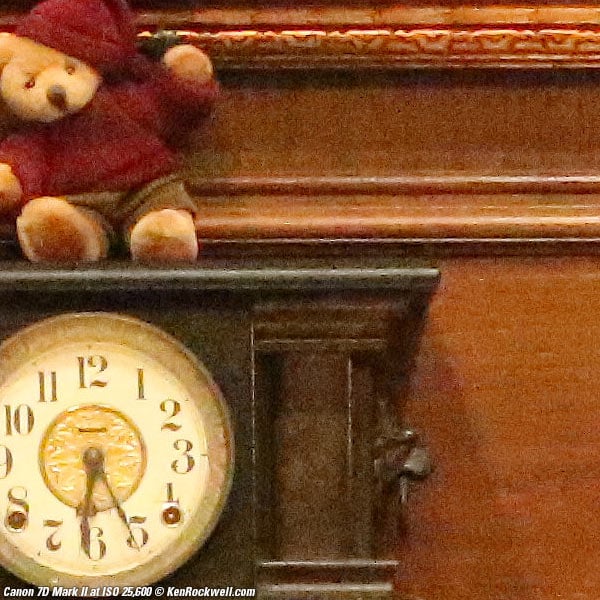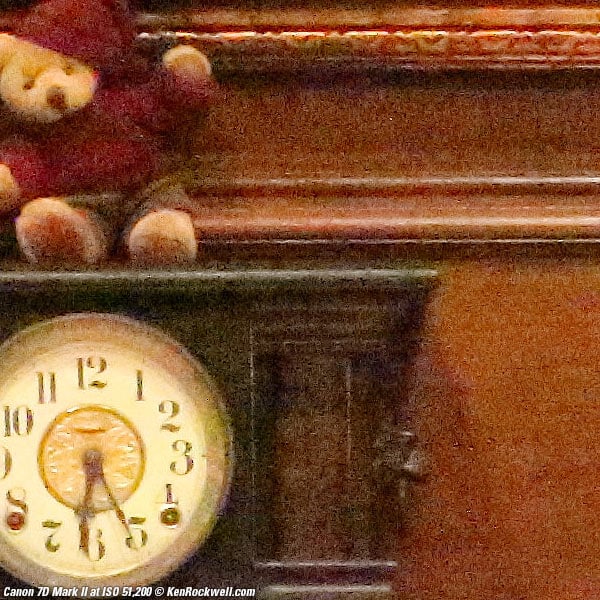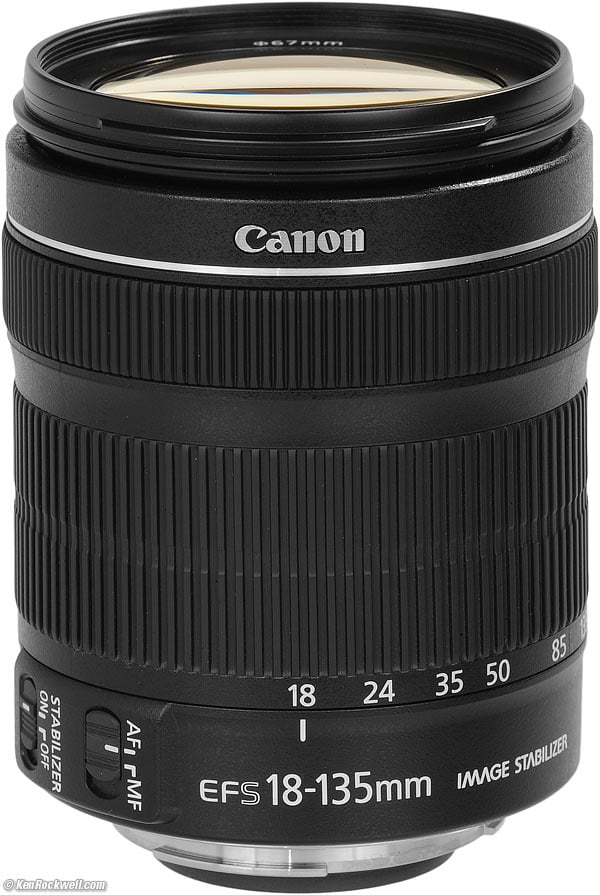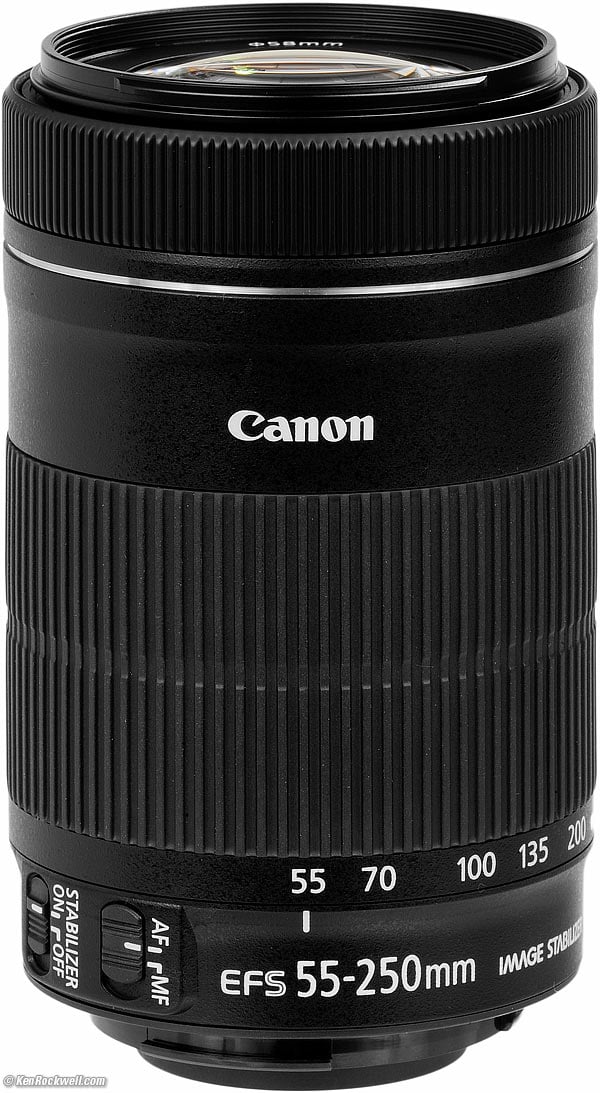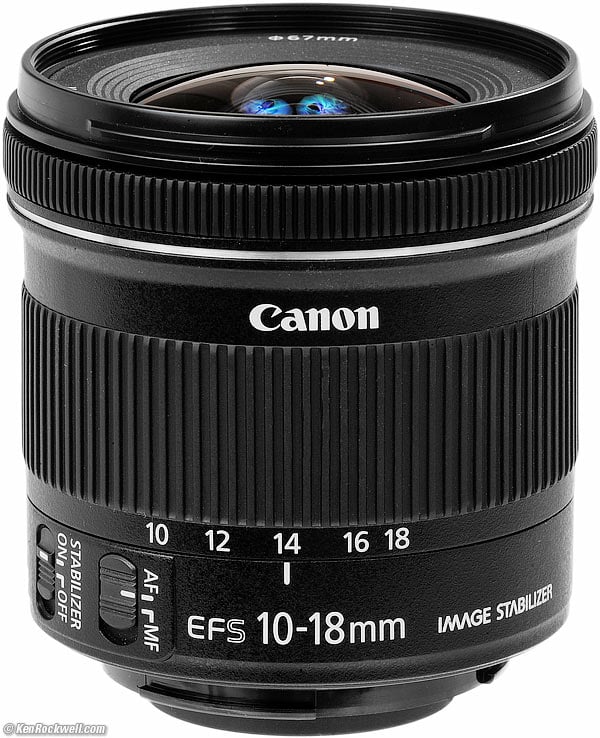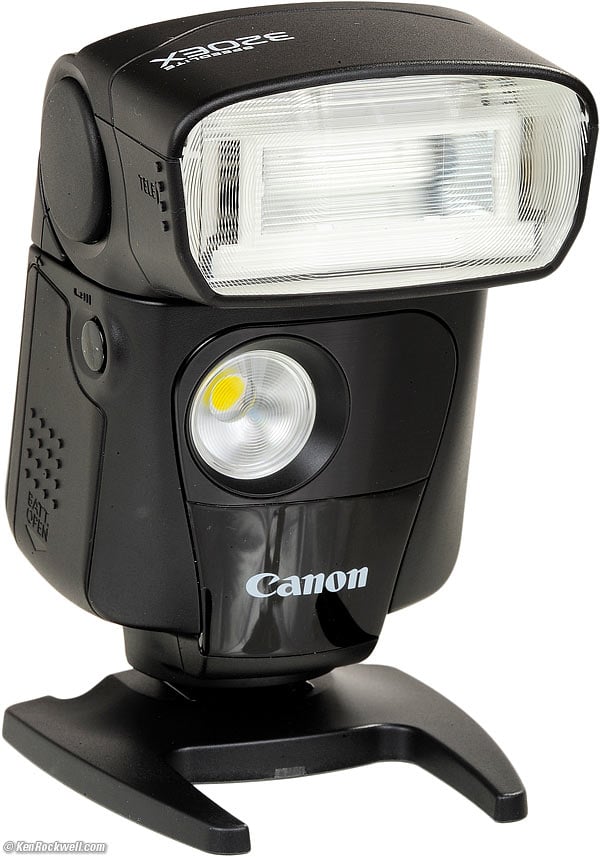Home Donate New Search Gallery Reviews How-To Books Links Workshops About Contact
Canon
7D Mark II
20MP APS-C, 10 FPS
Intro Specs Accessories Performance
Compared Usage Recommendations More
Canon 7D Mark II (31.8 oz./901 g with battery and card, about $900 used if you know How to Win at eBay) and Canon EF 35mm f/1.4 L. enlarge. I'd also get it at Amazon.
This all-content, junk-free website's biggest source of support is when you use any of these links to approved sources when you get anything, regardless of the country in which you live. Canon does not seal its boxes, so never buy at retail or any source not on my personally approved list since you'll have no way of knowing if you're getting a defective or damaged customer return or a used camera. Buy only from the approved sources I use myself for the best prices, service, return policies and selection. Thanks for your support! Ken.
March 2022 Canon Reviews Canon Lenses All Reviews
NEW: Pro DSLR Comparison 03 February 2016
Canon 7D Mk II. enlarge. Note the new AF Area Mode lever around the small thumb controller.
Canon 7D Mk II. enlarge.
Canon 7D Mk and Canon EF 35mm f/1.4 L. enlarge.
Sample Image Files top
Streetlamp with moon, 28 January 2015. (Canon 7D Mk II at Auto ISO 400, Canon 24mm f/2.8 STM with Nikon L37c filter, f/2.8 at 1/30 hand-held, no lens profile, Perfectly Clear V2.) full-resolution file.
Colors and shadows at the new park, 28 January 2015. (Canon 7D Mk II at Auto ISO 5,000, Canon 24mm f/2.8 STM, f/2.8 at 1/40 hand-held, no lens profile, Perfectly Clear V2.) full-resolution file.
La Especial Norte, 28 January 2015. (Canon 7D Mk II at ISO 640, Canon 24mm f/2.8 STM, f/2.8 at 1/40 hand-held, no lens profile, Perfectly Clear V2.) bigger.
Christmas Tree, 12 December 2014. Canon 7D Mk II at Auto ISO 2,000, Canon EF 35mm f/1.4 L, f/1.8 at 1/100, Perfectly Clear V2. enlarge.
OK, so we've gotten the "is it sharp" and "is it good at high ISOs?" questions out of the way.
Ryan and Katie at breakfast. (Canon 7D Mk II at ISO 200, Canon EF 35mm f/1.4 L, f/2.5 at 1/125, Perfectly Clear V2.) bigger.
Sharp enough? Palm, 17 January 2015. (Canon 7D Mk II, Canon EF 50mm f/1.2 L, f/5.6 at 1/320, Perfectly Clear V2.) bigger or full-size. If it's this sharp on APS-C at 20 MP, it's this sharp on full-frame at 52 MP.
Sharp enough? Palm Trunk, 17 January 2015. (Canon 7D Mk II, Canon EF 24-70mm f/2.8 L II, f/9 at 1/100, Perfectly Clear V2.) Unprocessed camera-original file. If it's this sharp on APS-C at 20 MP, it's this sharp on full-frame at 52 MP. Remember that trunks are curved, so only the central strip is in focus.
Introduction top
Intro Specs Accessories Performance
Compared Usage Recommendations More
The Canon 7D Mark II is the world's best camera for shooting indoor or night sports. Unless you have installed special lighting at the arena so you can use an older pro camera like the Canon 1D X or Nikon D4S, the new 7D Mk II has a special new flicker-compensating feature that lets you get consistently great photos without the random dark frames caused by most artificial lighting.
Even in daylight, the 7D Mk II is the best camera for less than $6,000 for shooting any kind of action because of its extremely high 10 FPS frame rate. Only a huge $6,500 pro camera goes faster.
The 7D Mk II is the world's fastest APS-C camera and has more processing power than any EOS camera. It's faster than any of Nikon's pro DX cameras like the D2HS. For sports, unless you're a full-time Sports Illustrated shooter with a $6,800 Canon 1D X or Nikon D4S, the 7D Mk II just became the new world's best sports camera, in most artificial light, no camera is better at any price.
The 7D Mark II's AF sensor array covers most of the frame, unlike full-frame cameras whose AF areas are still all stuck in the middle. Will this lead to pros abandoning the 1D X and Nikon D4S so we can focus all over our frame? It just might! Who said this was a consumer camera? Its shutter is rated for 200,000 shots!
The 7D Mk II super-fast and technically and ergonomically top-notch. Besides having essentially the same resolution as full-frame, high ISO performance is also spectacular. It's not 2007 anymore; today APS-C is technically magnificent as well.
Pros have always had to bring or install our own huge multi-head strobe systems around an indoor arena to provide our own lighting, since most arena lighting, like mercury vapor, flickers at high rates. If you've ever noticed your indoor or night sports shots having occasional weird exposure or color, it's because these lights flicker faster than our eyes can see, but at 1/125 and above, cameras see this flickering.
If your camera fires at the same instant the arena lights flicker off, you get a dark frame.
If you're not setting up your own strobe system or have high-frequency ballasts at the arena, the 7D Mk II is the world's best camera for shooting indoor or night sports, period.
The problem with fluorescent, LED, sodium-vapor and especially the mercury lighting used in arenas is that while our eyes don't see anything flickering, these lights flicker at twice the power line frequency (100 Hz or 120 Hz). When you shoot at faster shutter speeds, you run the risk of making an exposure at the moment the lights are dark! That's why so many amateur indoor and night sports shots have random dark and off-color frames.
The 7D Mark II is the first camera smart enough to see the flickering, and shift the exact moment of exposure by a few milliseconds to avoid the dark or off-color periods. This was less of a problem in the old days when ISOs were low, but today where it's easy to shoot at 1/500 or more, this is a huge problem under artificial light with other cameras.
I love the new flicker-fixing feature. Shooting flickering LED Christmas lights this season, my 7D Mk II always got the lights lit; never getting a dark shot at the instant the LEDs went off for part of the power line cycle. Brilliant!
I can shoot ice hockey indoors and it comes out properly without needing strobes, whoo hoo!
I've owned my more expensive 5D Mark III since it came out, and the 7D Mk II feels and handles like the same camera — while adding several clever new features like a new AF area mode selector concentric to the thumb nubbin.
New also is a "Bulb Timer," which means you can program the length of your long exposure in a menu. Press the shutter, and if you want a 2 hour, 35 minute and 23 second exposure, the 7D Mk II will do it while you go back to sleep — no external anything required.
The old Canon 7D of 2009-2014 was always great, and now 5 years later, the Mark II is way ahead, adding many more focus points than ever before: 65 cross points. Not only does the 7D Mark II have many more AF sensors; the central sensor is extremely sensitive, down to LV -3.
While Nikon has replaced most of its external AF controls with video controls instead, the Canon 7D Mark II adds a new AF Mode selection lever around the small thumb-nubbin controller.
Canon also adds in the 7D Mark II "dual pixel AF" for faster video and Live View autofocus.
Added is another first for Canon: as-shot automatic distortion correction for most lenses made in the past 20 years:
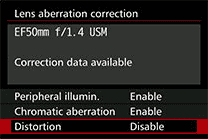
New in-camera distortion correction.
There's a new 150,000-pixel RGB+IR 252-zone metering system. As far as I know, it's the first camera with a meter sensitive to infra-red to identify the subject to help the camera calculate the best exposure. This meter is way beyond the 63-zone meter of the 5D Mark III.
There is a new LP-E6N battery (interchangeable with the old LP-E6) and a new BG-E16 grip.
There is no Wi-Fi, but there is GPS and a new magnetic compass to record the direction in which the camera was pointed as well as its location. I'll take this over WiFi any day, and there is a wireless file transmitter if you really need one. Since the 7D Mark II is going to see a lot of professional use for sports, the outboard WFT E7A v2 wireless file transmitter is much better for arena applications than some wimpy internal WiFi transmitter.
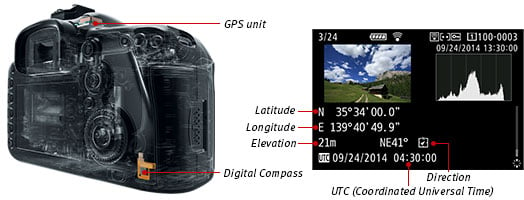
Specifications top
Intro Specs Accessories Performance
Compared Usage Recommendations More
Body
Canon 7D Mk II magnesium alloy body. bigger.
Magnesium alloy.
Autofocus
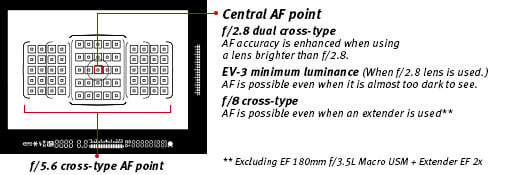
65 cross points.
A new AF Mode selection lever is around the little rear thumb nubbin.
AF-assist light.
Lens Compatibility
Front, Canon 7D Mk II. enlarge.
All Canon EOS EF and EF-S lenses made since the 1980s work perfectly.
The only Canon lenses that don't work are the old manual focus FD lenses and earlier.
Light Meter
150,000-pixel RGB+IR meter sensor.
EOS iSA System for 252-zone Evaluative, as well as 6% central and 1.8% spot metering as read from that 150,000 pixel sensor.
Paradoxically, spot metering is only from the center sensor; AF-point linked spot metering isn't there.
Can read light flicker and the camera can be set to offset its shutter delay to optimize color and exposure under flickering sports arena lighting.
Meter range: LV 1~20.
Sensor
Size
22.4 x 15.0 mm (APS-C).
Pixels
20 Megapixels.
Wells are 4.1µm square.
JPG and/or RAW: LARGE (20 MP ) 5,472 x 3,648 pixels native.
JPG MEDIUM (9 MP) 3,648 x 2,432 pixels.
JPG SMALL 1 (5 MP) 2,736 x 1,824 pixels.
JPG SMALL 2 (2.5 MP) 1,920 x 1,280 pixels.
JPG SMALL 3 (0.35 MP) 720 x 480 pixels.
M-RAW (11 MP) 4,104 x 2,736 pixels.
S-RAW (5 MP) 2,736 x 1,824 pixels.
ISO
ISO 100 - 16,000, special modes for ISO 25,600 and ISO 51,200.
Auto ISO
ISO 100 - 16,000 in most modes.
With flash, Auto ISO is fixed at 400, but will dip to 100 if overexposure would happen. If bouncing the flash, Auto ISO will vary from ISO 400 to 1,600.
In Bulb, Auto ISO is fixed at 400.
White Balance
Auto (AWB)
Daylight
Shade
Cloudy (also called Twilight or Sunset).
Tungsten
White Fluorescent
Flash
Custom gray-card
Kelvin color temperature
±9 levels of blue/amber and ±9 levels of magenta/green bias.
Color Spaces
sRGB and Adobe RGB.
Cleaner
Ultrasonic cleaner.
Dust delete data.
Shutter
Soft-touch electromagnetic release.
Vertical focal plane.
1/8,000 ~ 30 seconds and Bulb.
Rated 200,000 shots.
2s or 10s self timer.
Intervalometer.
Bulb timer: A menu lets you set exactly how long will be your Bulb exposure up 99 hours, 59 minutes and 59 seconds.
Frame Rates
10 FPS and slower.
Burst length: 31-frames RAW or 1,090 frames JPG, presuming your card is fast enough.
Shutter Lag
55 ms.
With flash: 95 ms.
Silent mode: 105 ms.
Silent mode with flash: 145 ms.
These are presuming the 7D Mk II is already awake. Camera turn-on time is an additional 120 ms if the camera is asleep.
Flash Sync
1/250.
Flash exposure lock (FEL).
Built-in Flash
Built-in.
Can command remote flashes.
External Flash
E-TTL II for use with all EX flashes.
Prontor-Compur (PC) terminal for studio and handle-mount flash guns. Works with either polarity.
Finder
100% coverage.
56% magnification with standard (on APS-C) 28mm lens. (100% with telephoto 50mm lens.)
29.6º apparent angle.
22mm eyepoint.
-3 ~ +1 diopters.
Standard Eh-A screen. Optional Eh-S screen for precise manual focus and depth-of-field when shooting fast lenses.
Finder shows:
AF Point Information
Spot Metering Circle
Electronic Level
Grid
Shooting Mode
White Balance
Drive Mode
Focusing Modes
Metering Modes
JPEG/RAW
Flicker Detection
AF Status Indicator
Warning Symbol

Can superimpose a your choice of camera settings data like a dual-mode electronic level display, grid, exposure mode, white balance mode and AF mode.
Depth-of-field preview.
Level
Two-axis.
1º increments.
On rear LCD: 360º roll and ±10º pitch.
In viewfinder: ±7.5º roll and ±4º pitch.
Live View
Still and video.
AF during Live View.
Grid.
Meter range: LV 0 ~ 20.
Video
.MOV files
MPEG-4 AVC / H.264 video with linear PCM stereo audio.
1,920 x 1,080 at 59.94p, 29.97p, 24.00p and 23.976p.
1,280 x 720 at 59.94i.
640 x 480 at 29.976p.
.MP4 files
MPEG-4 AVC / H.264 with variable bit rate video with AAC audio.
1,920 x 1,080 at 59.94p, 29.97p, 24.00p and 23.976p.
1,280 x 720 at 59.94p and 29.97p
640 x 480 at 29.976p.
LCD Monitor
3.0"
1,040,000 dots.
Auto brightness control.
Top LCD
Canon 7D Mk II top LCD backlight. bigger.
Storage
One CF type 1 and one SD card slot.
Works with up to UDMA CF cards. (Unlike the 7D, no longer thick enough for microdrives.)
SD slot for SD, SDHC, SDXC, and UHS-1 cards.
Can be set to record to both at the same time.
GPS and Built-in Magnetic Compass
Can record time, date, location, elevation above MSL as well as direction the camera is pointed, all in EXIF.
Connectors
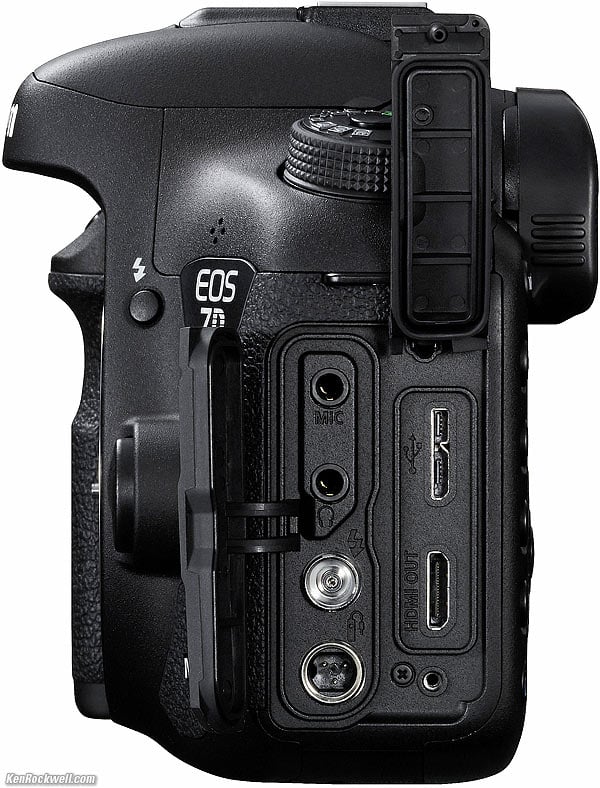
Canon 7D Mk II connectors, left side.
Mic.
Headphones.
Prontor-Compur (PC) flash sync.
Remote cord connection.
USB 3.0.
HDMI.
NTSC or PAL analog video.
Power
Either of the LP-E6N (new, included) or the old LP-E6 batteries work.
The LP-E6N is rated for 800 shots.
The new one has more capacity than the older LP-E6 battery.
The old and new LP-E6 and LP-E6N batteries are interchangeable.
They both charge in the usual Canon LC-E6 charger.
LP-E6N Battery (looks the same as the LP-E6 of the 7D).
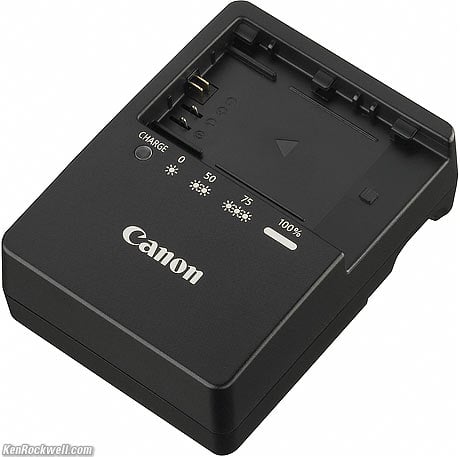
LC-E6 Charger.
LC-E6 folding plug 100-240V 50-60 cps charger.
Optional AC Adapter Kit ACK-E6.
BG-E16 grip lets two battery packs (LP-E6N or LP-E6) or six AA cells be used.
The clock has an internal rechargeable battery that can keep time for 3 months all by itself.
Size
5.85 x 4.43 x 3.08 inches WHD.
148.6 x 112.4 x 78.2 millimeters WHD.
Weight
Actual Measured
31.798 oz. (901.47 g) with battery and card.
Rated
32.1 oz. (910 g) with battery and card.
28.9 oz. (820 g) stripped naked.
Quality
Bottom, Canon 7D Mk II. enlarge.
Made in Japan.
Environment, operating
32º ~ 104º F.
0º ~ 40ºC.
Not more than 85% RH.
Announced
15 September 2014, 8:02 AM NYC time.
Available
November 2014.
Price, USA
September 2015: $1,499 body only; $1,849 as a kit with 18-135mm STM.
August 2015: $1,249 body only after rebate.
September 2014: $1,799 body only, $2,149 as a kit with 18-135mm STM.
Box, Canon 7D Mk II. enlarge.
Accessories top
Intro Specs Accessories Performance
Compared Usage Recommendations More
NEW: Canon LP-E6N battery (included)
The new LP-E6N has more capacity than the old LP-E6 battery.
The two are interchangeable with each other.
Canon WFT-E7A v2.
Canon WFT-E7A v2.
NEW: Canon WFT-E7A v2.
Optional wireless file transmitter for the 7D Mk II.
Canon 7D Mk II with BG-E16 grip and 18-135mm IS STM. enlarge.
Back, BG-E16 grip. enlarge.
Front, BG-E16 grip. enlarge.
NEW: Canon BG-E16 grip.
Holds two LP-E6N or LP-E6, or 6-AA cells.
Performance top
Intro Specs Accessories Performance
Compared Usage Recommendations More
Overall Autofocus Finder Ergonomics
Frame Rate Color High ISOs Flash
Playback Rear LCD Top LCD Data Clock Accuracy
Overall Performance top
It's fantastic. The original 7D was so far ahead of its time it sold for top dollar for 5 years as Canon's top APS-C camera, even while other models came and went.
Today, the 7D Mk II is again 5 years ahead of every other APS-C camera. Look how it handles harsh light and makes it beutiful, just look at the glint of the sun off the bubble on the right:
Katie, Charlie and Ryan backlit with big bubbles, 17 January 2015. (Canon 7D Mk II at ISO 200, Canon 320EX, Canon 24-70mm f/2.8 L II, f/16 at 1/250, Perfectly Clear V2.) Bigger.
Autofocus Performance top
As we expect, AF it top notch. It's fast, always right-on and the senors cover most of the frame — better than full-frame cameras whose AF only works in the center.
Accuracy
My 7D Mk II is well enough adjusted that its focus is right-on even at f/1.2 with no fine tuning need.
It's perfect also with my EF 24mm f/1.4 L II.
No worries here, and if there are, it's easy to set fine-tuning adjustments.
AF Zones
AF areas cover most of the frame.
The finder shows active AF areas as black squares.
I never saw any illumination. They are invisible in the dark.
Face Recognition
While there might be face recognition for video or Live View or playback, there is no face recognition when shot via the viewfinder. That's too bad, because you have to assign AF areas manually as people move around.
Even without face recognition for normal viewfinder shooting, it's fast and sure in its auto-area select mode finding and tracking my kids at work:
Katie on the spinny thing, 28 January 2015. (Canon 7D Mk II at Auto ISO 400, Canon 24mm f/2.8 STM, f/3.2 at 1/125, Perfectly Clear V2.) bigger.
Auto Area AF
The Auto Area AF function works quickly and then tracks whatever it finds all over the finder.
The Auto Area function looks for what's closest, not for faces.
Auto Area AF easily tracks subjects all over the frame as they move around. It's magnificent for tracking birds or aircraft against the sky, but if you have a small target flying against a background of trees, the AF system often will get lost and focus on the background as it's tracking.
Use a single AF area and keep the subject under it if you want to track moving targets against a busy background.
AF Assist light
There is no AF assist light.
If you set this, it will try to use repeated bursts of the flash to help it focus.
While this may be useful for photographing dead things, it's blinding and therefore not acceptable for people photos.
Luckily it's easy to set this on or off in a menu.
It's also easy to program it only to use the infra-red AF assist beam on an external flash or fire the external flash if needed for AF assist.
More
The AF system has a zillion settings.
It works as above at its defaults.
I'm sure if you have other needs that you should be able to program it to work even better. The best way to figure it out is to phone Canon USA (presuming you're in the USA) at (800) OK-CANON and ask them about your particular situation.
Finder Performance top
The finder is big, sharp and bright.
It's life-sized with a 50mm lens.
AF areas are indicated with black LCD square boxes, not red LEDs. I never saw any illumination of these boxes at night; they simply become invisible.
There is a load of information along the bottom, including the battery charge.
This is new: as you move the mode dial, little gray indicators are superimposed over the bottom left of the screen.
When setting the basics (WB, ISO, metering, etc.) with the little buttons near the shutter, little icons again appear on the screen. These are illuminated; I have no idea why the other aspects of the screen don't illuminate.
The screen's matte area is optimized for lenses of f/2.2 and faster.
Ergonomics Performance top
I love Canon's C1, C2 and C3 modes on the top dial. They recall everything about your camera settings: resolution, auto ISO settings, all your AF system and sensor setting, picture and color controls, white balance, advance modes, and well, everything you'd want saved. See Usage for how I set mine.
The rubberlike covering is super grippy, and the curved covers always are comfortable and soft — unlike Nikon's hard edges.
The menu system now uses Frutiger-esque fonts that are very easy to read.
The self-timer tally light is amber.
The weirdest thing about the 7D Mark II is that it vents its mirror box out the three little holes on the bottom left of the rear LCD. This means that air blows on your lips as you zoom most lenses!
Frame Rate Performance top
Sure, it runs at 10 FPS on paper, but that doesn't matter. Plenty of mirrorless cameras claim crazy-fast frame rates, but they are lies because those cameras can't focus fast enough to keep moving subjects in focus at those frame rates. What matters is how fast it runs while tracking autofocus on moving targets.
The great news is that my 7D Mk II actually runs at 8 or 9 real frames per second while tracking focus on real subjects in motion. Bravo! Most SLRs get much slower when you actually expect them to track real moving targets — the whole point of high frame rates.
For sports and action, frames-per-second is everything. In the snaps below, the similar frames in the series just 100 milliseconds before or after were completely different and not used:
Katie sledding, 14 December 2014. (Canon 7D Mk II at ISO 400, Canon EF 28-105mm USM II at 73mm, f/10 at 1/640, Perfectly Clear V2.) bigger.
Katie slams the piñata, 14 December 2014. (Canon 7D Mk II at ISO 200, Canon EF 28-105mm USM II at 30mm, f/5 at 1/125, Perfectly Clear V2.) bigger.
Bruiser slams the piñata, 14 December 2014. (Canon 7D Mk II at ISO 160, Canon EF 28-105mm USM II at 28mm, f/6.3 at 1/125, Perfectly Clear V2.) bigger.
Color Rendition performance top
Towel in shade. (Canon 7D Mk II at ISO 100, Canon EF 28-105mm USM II at 28mm, f/7.1 at 1/160.) bigger.
Color rendition is superb, and matches my other Canons since 2012 or before. The Picture Styles are all the same.
High ISOs Performance top
High ISO performance is spectacular.
Here are frames shot with a Canon EF 35mm f/1.4 L at f/4 from ISO 100 through ISO 51,200. Shutter speeds varied from 4 seconds to 1/125. These were shot as NORMAL LARGE JPGs with +4 Saturation and 7 Sharpening.
First I'll show all the complete images, and then crops at 100% from the center for all of them. The crops have my usual sharpening added for web content as does everything you see on-page.
Click any image for the © camera-original files for your own perusal.
Complete Images
The absolutely awesome lesson here is that even at the completely insane ISO of 51,200, it still looks fine for online use. The biggest issue is that the shadows are not quite as dark and contrasty as at the almost-as-insane ISO of 25,600, but if you need ISO 51,200 for some project, go for it:
Crops at 100%
If these are 6" (15cm) on your screen, then printing a complete image at this same high magnification would result in a mammoth 55" x 37" (1.5 x 1.0 meter) print.
Click any for the © camera-original files for your own perusal.
What you'll see here, like all digital cameras today, is that noise isn't the problem at high ISOs. Noise reduction does a great job of smearing-over the noise, which also smears-over the textures and detail at the same time. What you'll see is that most of the finer parts of the image are simply erased as the ISOs climb into sillytown.
Noise isn't the problem; the real question is how far you can enlarge images made at foolish ISOs before the softness becomes obvious.
Look at the grain in the wood and the texture in the bear's sweater: it simply goes away as ISOs increase. Camera noise reduction does a great job of keeping the noise from rising and saving sharp edges; what you lose is subtle textures.
Flash performance top
Built in
Exposure is fine.
Like most built-in flashes, the built-in flash recycles slowly.
External
All EX flashes work great.
I get marvelous exposure with my 320EX.
Playback performance top
The partial-info mode now puts dark bars across your images, obscuring more of them than necessary and more than older cameras do.
There are more data display modes that add a few new things, like lens and focal length. It's still not smart enough to tell you if you used a lens or the -II version, even though the EXIF knows.
My complaint is that while there are now more screens to show more data, the data I acually need is now smaller; my 5D Mk III makes what I need much clearer on fewer screens.
It can't display file prefix.
It's not smart enough to swap to different AF points on zoomed playback.
Old problems never die:
1.) You're still locked out of many playback controls during just-shot Image Review. See Usage for how to fix it.
2.) Exactly as Canon has done since the 1990s, this hotter-than-hot new camera still can't show images in full detail instantly as you swap around images. As you select new images, you'll first see a slightly smaller and fuzzier image as is takes a fraction of a second to draw the image full-size in full resolution.
Rear LCD performance top
As we expect, the rear LCD is sharp, clear, smooth, bright and has accurate colors.
In daylight and Auto brightness mode, it will appear to wash-out the highlights attempting to make the screen bright enough. This is where you use your histograms to check exposure, since the screen will look overexposed.
The screen is anti-reflection coated for deep blacks.
Top LCD performance top
The top LCD is standard for Canon. It has an amber backlight at night.
The top LCD finally, after about 15 years, has a 3.5 digit frame counter.
Power & Battery performance top
I get the usual 1,000 or more shots per charge.
New in the menu system is that Canon renamed the battery health indicator to "Recharge Performance." This is a rough idea of how healthy is your battery long-term, not how many shots are left on this charge.
Recharge performance is a rough idea as to how many more times you can charge and discharge the battery before you need to replace it.
Data performance top
It has a USB 3 socket, and should also work with regular micro USB cables as well.
The menus talk about card 1 or card 2, not referring to them as CF or SD. You have to look at the icons carefully for their shape to figure out about which it's speaking.
Clock Accuracy performance top
Every sample is completely different, and my 7D Mk II is superb.
It has lost only 1 second in the past 40 days, or less than one second per month.
BRAVO!!!
Compared top
Intro Specs Accessories Performance
Compared Usage Recommendations More
Ignoring the new features of the 7D Mk II, the major difference between the 7D Mk II and the 5D Mk II are format (full frame is better for landscapes, while the 7D Mk II is better for telephoto and sports work), and frame rates. The 7D Mk II is much faster than the 5D Mk III.
The 7D Mk II has a slightly smaller finder but more depth of field than a full-frame camera. If you think that the larger format has lower noise at high ISOs, think again. It's not 2006 anymore; today, APS-C and full-frame both work great at crazy-high ISOs.
7D Mk II |
||||
| Announced | 9/2014 |
9/2009 |
3/2012 |
10/2011 |
| Sensor | APS-C |
APS-C |
Full-Frame |
Full-Frame |
| Frame Rate | 10 FPS |
8 FPS |
6 FPS |
12 FPS |
| Shutter life | 200,000 shots |
150,000 shots |
150,000 shots |
400,000 shots |
| Resolution | 20MP |
18MP |
22MP |
18MP |
| Technical Image Quality | Excellent |
Good |
Excellent |
Excellent |
| Technical Image Quality, typical ambient arena/gym/pool lighting* | Very Good |
poor |
poor |
poor |
| AF Areas | 65 |
19 |
61 |
61 |
| Finder Clarity, AF locked | Good |
Poor |
Good |
Good |
| Finder Data Display | Very Good |
Good |
Good |
Good |
| Meter | 150,000 pixels RGB+IR, 253 zones |
63-zone, 2 color |
63-zone, 2 color |
100,000 pixels RGB+IR, 252 zones |
| LCD | Excellent |
Excellent |
Excellent |
Excellent |
| Battery Life, actual shots | 1,000 + |
1,000 + |
1,000 + |
1,000 + |
| Toughness | Mostly metal |
Half plastic |
Half plastic |
Mostly metal |
| Weight, wet | 32.1 oz. |
32.3 oz. |
33.7 oz. |
53.8 oz. |
| Weight, wet | 910 g. |
915g |
956 g |
1,526 g |
| Made in | Japan |
Japan |
Japan |
Japan |
| Excels for (all are great for general use) | Sports, especially night and indoor events |
bargain hunters |
Nature, landscape & portraits exhibited as art-gallery size prints |
full-time pro sports with access to custom arena lighting |
| Price, 8/2010 | n/a |
n/a |
n/a |
|
| Price, 9/2014 | $900 refurbished |
|||
| Price, 2/2015 | $600 used |
*Power-line flickers lead to weird color and exposure errors at fast shutter speeds demanding either your own strobe lighting or the 7D Mk II's ability to synchronize itself to these flickers
Compared to the Nikon D7100
The Nikon D7100 is primitive by comparison.
Unless face-recognition autofocus is important to you, everything else about the 7D Mk II just feels better and faster.
The D7100 feels like a consumer camera, while the 7D Mk II doesn't feel any different than Canon's top 5D Mk III.
If you already own a Nikon DX system or if photographing people with face-recognition AF, consider the D7100, but otherwise, forget Nikon and step up to the 7D Mk II.
Usage top
Intro Specs Accessories Performance
Compared Usage Recommendations More
AF Area Selection
Be sure to enable the rear multi controller (thumb nubbin) in Custom Controls in the yellow (wrench) section of the menu system to let you use it to select AF areas. At default, it ignores you.
I set the little flipper around the thumb nubbin to let me select among the various AF area modes, which I also have to set in the Custom Controls menu. This is where we set which knob and button does what.
You only can move the AF areas around while the meter is on. Several seconds after you take your finger off the shutter it goes back to sleep, and the nubbin will ignore you.
Image Review
It locks me out of many controls during just-shot Image Review, so I don't use that.
Instead, I program my SET button in the menus as a Zoom button. Now when I hit SET, it plays the image and it's already zoomed in, and I have total control. If I want to see the whole image, I tap SET again. Easy!
Bulb timer
The fourth red Camera menu lets you set a Bulb Timer, or how long will be your Bulb exposure.
It sets up 99 hours, 59 minutes and 59 seconds.
Lens Profiles
For automatic lens correction, data for many new lenses are already in your 7D Mk II.
The camera only holds data for up to 40 lenses. If your lens shows NO DATA when you set correction ON in the first page of camera menus, run EOS 3 utility on your computer to select and load profiles for your lenses.
Rear LCD
I leave it at Automatic Brightness, set in the second yellow Wrench menu.
While I'm in that menu, I turn the rear dial one click clockwise to get it one step brighter, still automatically controlled.
Mode Dial
Hint: One push from above with the pad of your thumb will unlock it, and then you can continue to rotate it with the same finger.
C1, C2 and C3 modes
I program these differently. I leave these in Auto Update Enable the first few days while I'm adjusting them to taste.
To program these, set your camera as you wish, and then save it to one of the three C positions using the menu system.
I set many more things than this; here are my basics:
C1 |
C2 |
C3 |
|
| Used for | General Scenics |
People and Family |
Sports |
| Exposure Mode | Pro (P) |
Pro (P) |
Pro (P) |
| Resolution | L |
S |
S |
| Picture Style | +3 or +4 Saturation |
0 Saturation |
0 Saturation |
| White Balance | Auto |
Auto |
Auto |
| ISO | Auto |
Auto |
Auto |
| Max Auto ISO | 16,000 |
16,000 |
16,000 |
| Minimum Auto ISO Shutter Speed | AUTO |
1/125 |
1/250 |
| Auto Light Optimizer | |||
| External Flash | disabled * |
enabled |
enabled |
| AF | ONE SHOT |
AI FOCUS |
AI SERVO |
| AF Sensors | One sensor |
Auto (all) |
One Sensor** |
| Advance | Continuous Silent |
Continuous Silent |
Continuous High (10 FPS) |
* When set to disable, the external flash's AF illuminator works, but the flash doesn't fire. Of course the flash fires by default; to disable it, use the first red camera menu > Flash Control > Flash firing > (enable or disable).
File prefixes
As shipped, file names start with four random characters. This way every camera has its own unique file names. This doesn't change unless you change it.
I set mine to my own preference in the menu system.
Recommendations top
Intro Specs Accessories Performance
Compared Usage Recommendations More
General recommendations top
For sports, especially with the world's first system that can "shoot through" flickering stadium lighting, the Canon 7D Mark II is the world's best indoor and night sports camera, better than the Canon 1D X and Nikon D4S unless you install a whole-arena strobe system or high-frequency ballasts. If you're shooting indoor or night sports at anything other than a major national venue, you'll need this 7D Mk II. This flicker shoot-through feature synchronizes your shutter automatically so you don't get random dark or color-shifted images.
The 7D Mk II is also a spectacular camera for every other kind of use. If you think you want one for general photography, landscapes, portraits or action, get one!
Only if you shoot subjects that don't move and really do exhibit at mural size or larger on a regular basis (few do), would I get a full frame camera like the 6D or 5D Mark III instead.
I've always loved the original 7D, and now the long-awaited 7D Mark II is everything the original 7D was — and a whole lot more. Heck, just look at my four-year-old Hawaii photos from the old 7D, and imagine that same quality at 10 frames per second with even better metering.
For under $1,800, my kids call this a "triple-nipple duh." The 7D Mark II is the obvious gotta have, especially for any kind of sports shooting unless you already have a $6,500 flagship.
Recommended Lenses recommendations top
Normal
Canon EF-S 18-135mm STM.
I'd use the 18-135mm STM; Canon offers the 7D Mk II as a kit with it. It's a fantastic lens for everything. The 18-135 STM is the only lens you'd need for just about everything with the 7D Mk II.
Canon EF 40mm STM.
For a much smaller lens, the 40mm f/2.8 is superb. Never carry both at the same time; see also Assembling a System.
If you like to carry too much, I use my 24-70/2.8 L II because I already own it for my full frame cameras. If you don't already own it, it's way too big and heavy to buy for use on APS-C, but it is an ideal focal range for APS-C cameras. If I shot my 7D full time instead of my full-frame, I'd buy the 18-135mm STM for it.
Telephoto
Canon 55-250mm STM.
For tele, the Canon EF-S 55-250mm STM is marvelous, small, light and inexpensive.
For a tougher pro-level tele, I own the 70-200/4 L IS; the f/2.8 models are too big and heavy, and we don't need f/2.8 with the insane high ISOs of the 7D Mk II; f/2.8 was for 35mm film.
If you like carry too much, the Canon 100-400mm IS L II has replaced all 70-200mm lenses because it focuses closer and faster; and it's insanely sharp. I use my 100-400 when I shoot my 7D Mk II because I already own one for full frame; if all I shot was the 7D Mk II I'd get the 55-250 instead for sanity's sake.
The 100-400 has astronomical reach at 400mm, but more importantly, focuses as close as the 55-250 — and the 100-400 focuses almost instantly for shooting sports! I would no longer bother with 70-200mm lenses. For head shots, the bokeh of the 100-400 is even better at 400mm than a 200mm at f/2.8.
Big lenses feel great when looking at them at a friend's house or browsing online, but when you have to carry them all day by yourself, it's a very different story.
Ultra Wide
Canon EF-S 10-18mm.
If you need an ultrawide, you're in luck: the world's cheapest ultrawide is also the world's best: the Canon EF-S 10-18mm STM.
There is no better ultra wide lens for the 7D Mk II, and everything else costs more, so this is the easy choice.
See also How to Use Ultrawide Lenses.
Recommended Flashes recommendations top
The built in flash is all you need for general people photos.
The reason you might want an external flash is for shooting quickly; the built-in flash may take 10 seconds to recharge after each shot, while an external flash will recharge almost instantly for the next shot.
I use an external flash when I intend to shoot a lot with daylight fill-flash.
If you're shooting a lot with flash, an external flash also lets you get more shots per camera-battery charge.
Canon 320EX.
If the built-in isn't fast enough for you, I use my Canon 320EX flash when I know I'm going to be using a lot of flash.
It's unusual that you'll need it, but if you need more range (power), the Canon 430EX II is a magnificent flash. I don't use one because it's much bigger and not that much more powerful, but if you feel better with a flash loaded with features and don't mind hauling it around your neck all day, the 430 EX II is superb.
The Canon 600EX-RT is intended for use in multiple flash setups by wedding pros. It's swell for other uses, but you're paying a huge premium in price and weight if all you intend to do is use it on top of your camera. I wouldn't buy a 600EX-RT for on-camera use.
Helping those who help us
My biggest source of support for this all-content, junk-free website is when you use these links to the 7D Mk II at Adorama (body only) or with the 18-135mm STM (recommended) or at Amazon, at B&H or at Crutchfield.
Using any of these links to approved sources when you get anything is my biggest source of support, but if you take your chances by buying elsewhere, I receive absolutely nothing in return for my efforts and expense in researching and sharing all this to help you.
Thanks!
Ken.
More Information top
Intro Specs Performance Accessories Compared
Canon 7D Mk II quick reference guide
Canon 7D Mark II basic user's manual
Canon 7D Mk II complete owner's manual
Canon USA's 7D Mark II press release
© Ken Rockwell. All rights reserved. Tous droits réservés.
Help me help you top
I support my growing family through this website, as crazy as it might seem.
The biggest help is when you use any of these links when you get anything, regardless of the country in which you live. It costs you nothing, and is this site's, and thus my family's, biggest source of support. These places have the best prices and service, which is why I've used them since before this website existed. I recommend them all personally.
If you find this page as helpful as a book you might have had to buy or a workshop you may have had to take, feel free to help me continue helping everyone.
If you've gotten your gear through one of my links or helped otherwise, you're family. It's great people like you who allow me to keep adding to this site full-time. Thanks!
If you haven't helped yet, please do, and consider helping me with a gift of $5.00.
As this page is copyrighted and formally registered, it is unlawful to make copies, especially in the form of printouts for personal use. If you wish to make a printout for personal use, you are granted one-time permission only if you PayPal me $5.00 per printout or part thereof. Thank you!
Thanks for reading!
Mr. & Mrs. Ken Rockwell, Ryan and Katie.
Home Donate New Search Gallery Reviews How-To Books Links Workshops About Contact
